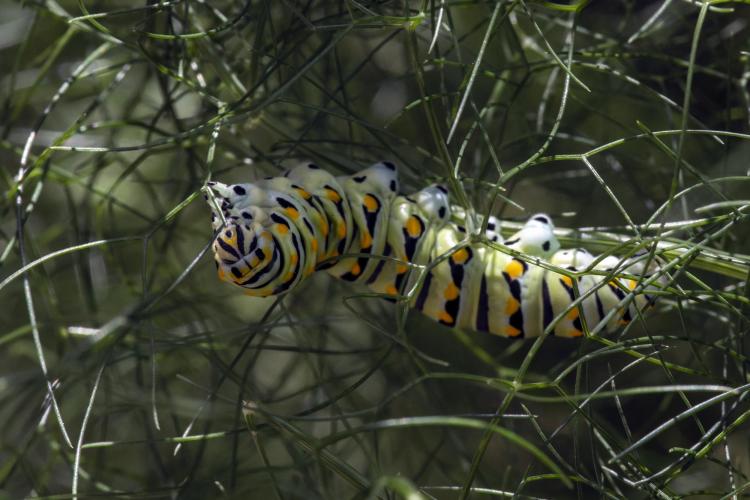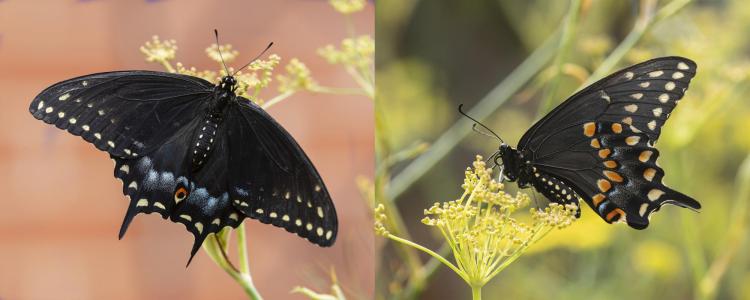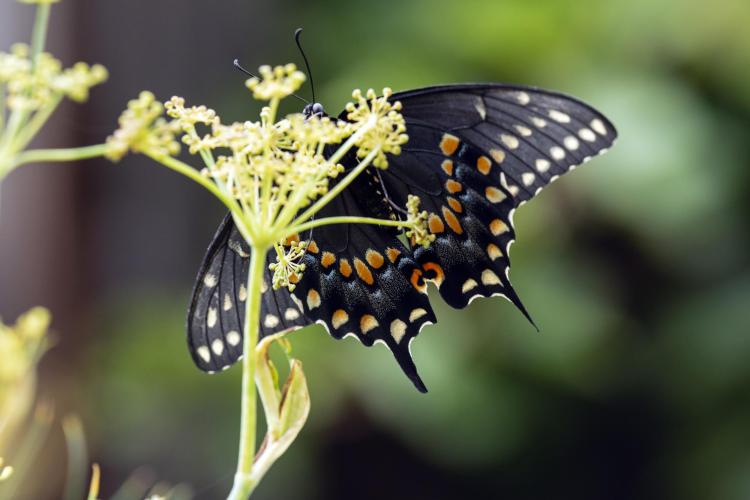Many roles of color patterns in black swallowtail butterflies
The colors and patterns of black swallowtails reveal the diversity of evolutionary dynamics acting on the sexes and the various life-history stages

Black swallowtails caterpillar. Photo by Jeff Mitton.
Six species of swallowtail butterflies occur locally, and they combine yellow, black, orange. blue and red in several diverse patterns that invariably catch the eye. We can marvel at them, but our enjoyment of these fluttering beauties is enhanced by an appreciation of the evolutionary forces acting on the color patterns. The stunning pattern of black swallowtails has attracted the activities of many biologists and their studies provide considerable insight into the natural history black swallowtails, Papilio polyxenes.
After an egg hatches, the caterpillar eats, grows and molts (sheds its skin) four times, passing through five instars to accommodate its growth. The first instar is black with a white band or saddle around its midsection. If the caterpillar does not move and if you do not look carefully, you will probably mistake it for a bird dropping. Some biologists assert that the first instar is a mimic of a bird dropping, but others seek another term because they feel that the similarity of an animal to an inanimate object does not fit into the concept of mimicry. A recent paper used the word masquerade for the caterpillar's similarity to a bird dropping, so we will go with that.
As caterpillars molt and grow they completely change their appearance. Fourth and fifth instars have white prolegs with black dots and their bodies have a series of colored rings: white, pale green, and black with large orange dots. Some authors have stated that these late instar colors are cryptic, making the caterpillar difficult to detect in the dappled sunlight within the foliage of a fennel or a wild carrot. I disagree. It seems to me that the bright orange, black, bright white and light green and sharply contrasting, adjacent colors make the caterpillars conspicuous, not cryptic.

Black swallowtails are mimics of poisonous pipevine swallowtails. Photo by Jeff Mitton.
Aposematic or warning coloration advertises something distasteful or noxious or poisonous. If the bright colors do not dissuade a predator, the caterpillar everts its osmeterium, a structure on its head with two prongs, secreting a foul and irritating slime of chemicals. The caterpillar aggressively rubs the osmeterium against the ant or other predator to repel it.

Black swallowtails are mimics of poisonous pipevine swallowtails. Photo by Jeff Mitton.
Black swallowtail adults are sexually dimorphic, meaning that they have different color patterns--their ventral wing surfaces and their bodies are the same but their dorsal patterns differ. Thorax and abdomen are black with yellow dots, and on the ventral side, the forewings have two rows of yellow dots on a black background. The ventral sides of the hindwings display two rows of orange spots with subtle yellow edges and diffuse clouds of tiny blue dots between the rows. This pattern is quite similar to that of the pipevine swallowtail, Battus philenor, whose geographic range overlaps the range of the black swallowtail. The pipevine swallowtail is highly poisonous, for its caterpillars feed on plants in the genus Aristolochia, which are defended by aristolochic acids. Pipevine swallowtail caterpillars consume the leaves and store or sequester poisonous aristolochic acids, which are retained by pupae and adults. Pipevine swallowtails are aposematically colored--the orange spots on the ventral hindwings warn of chemical defenses. Black swallowtail adults have no chemical defenses, but their similarity to a poisonous butterfly makes predators wary, protecting the undefended black swallowtails. Protection gained from similarity to a poisonous model is called mimicry.
The dorsal patterns of female black swallowtails and pipevine swallowtails are very similar--two rows of yellow dots, diffuse clouds of tiny blue dots, and an orange, yellow and black eyespot-- extending mimicry to the dorsal surfaces. Male black swallowtails have different dorsal patterns--much more yellow, very little blue, an eyespot. So, males have the protection of mimicry when they are resting with wings folded together over the abdomen. But they are not mimetic when they spread their wings to gather heat from sunlight. So why do males have this pattern, which seems to put them at a disadvantage?
Some males have dorsal patterns that look like that of the females. Studies comparing males with female patterns and traditional males found that females showed no mating preference. But when it came to the stiff competition among males for mating territories, males with female patterns were at a disadvantage. Males with good mating territories mated with many females, but those without territories had little or no opportunity for reproduction. This is sexual selection, which is natural selection in the context of mating. So traditional males lose some degree of mimicry, but win the contests for mating territories.
The colors and patterns of black swallowtails reveal the diversity of evolutionary dynamics acting on the sexes and the various life-history stages. Caterpillars start off masquerading as bird droppings but switch to aposematic coloration. Adult females mimic a poisonous species. Males have ventral color patterns for mimicry and most males develop a dorsal pattern that provides an edge during competitions to acquire and keep a mating territory. A few males develop the female dorsal pattern, enhancing their mimicry. A glimpse of a black swallowtail sipping nectar from a flower gives the impression of a serene insect with an idyllic existence. But careful studies reveal a life filled with hazards and challenges.

